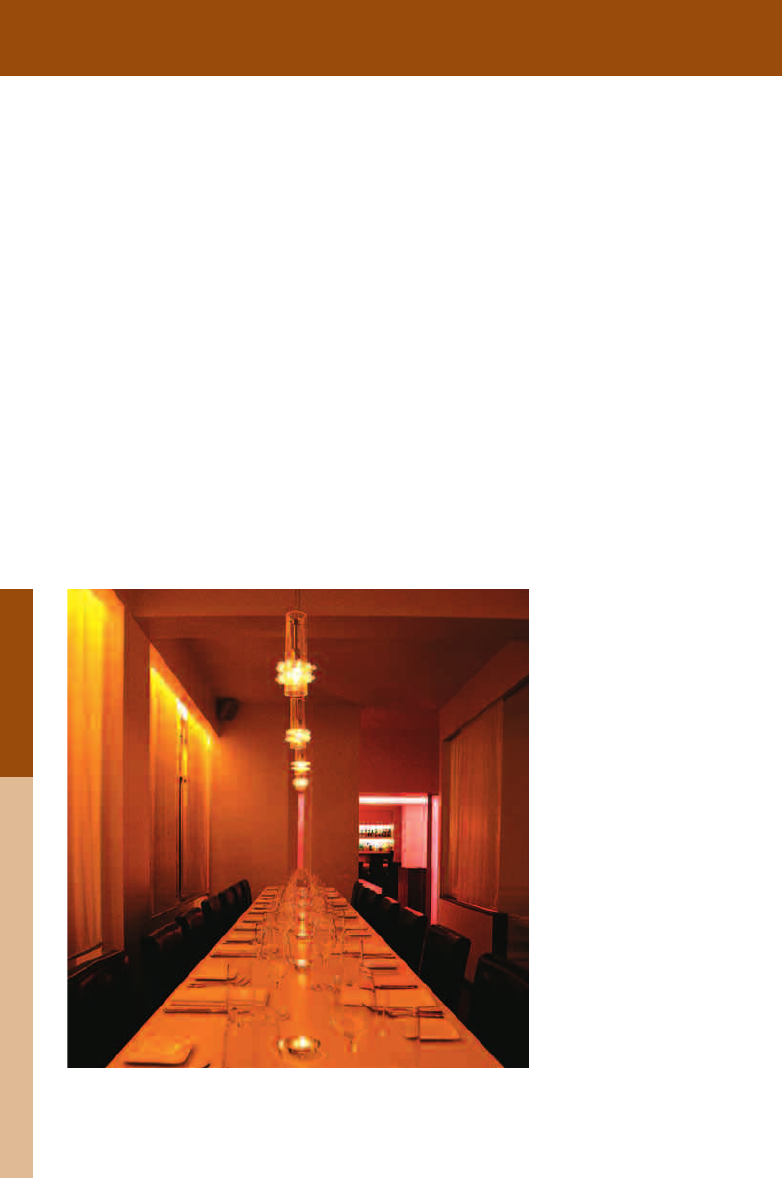
14
Job:02-30056 Title: RP-Interior Design Reference and Specification
#175 Dtp:216 Page:218
(RAY)
218-223_30056.indd 218 3/4/13 7:51 PM
218
THE INTERIOR DESIGN REFERENCE + SPECIFICATION BOOK
Text
Chapter 14: Artificial Light
Consider a strongly evocative interior space, one where the mood is immediately
striking, and chances are high that lighting played a central role in its design. In a
restaurant that is both cozy and contemporary, for instance, articial lighting will
inform the design features and the character of the space. Simple surfaces and
colors will have been selected to take best advantage of the light: Walls might be
a warm, buttery yellow, and mirrors and other reective surfaces used to throw the
focal glow of candles and soft light around the room.
Lighting design that creates a mood is based on an approach that is at odds with
lighting design that seeks evenly distributed and specic lighting levels. This kind
of “perfect” all-over task lighting may be appropriate for exible ofce space, but it
fails to produce an imaginative setting for most other human activities. By under-
standing the specic tasks intended for a space, however, the designer can readily
determine the appropriate lighting strategies that will integrate function and inspira-
tion into a design.
TYPES OF LIGHTING
Articial lighting is best examined according to the function it performs, typically described
as
space. Ideally, the ambient light source comes from different xtures that can be individually
controlled and dimmed depending on the time of day or amount of natural light available.
Accent lighting acts as a spotlight to illuminate a specic artwork, architectural detail, or piece
of furniture. Accent lights are typically low-voltage xtures that can be manually adjusted to
focus on a particular object. To avoid glare, the light source should be at a
the object.
Unlike ambient or accent lighting sources, chandeliers, wall scones, and lamps draw the eye
to themselves. These glowing objects serve as focal points in a room and, in fact, are often
referred to as
focal glow.
Task lighting provides light for a specic activity. In a typical ofce space, the light levels are
evenly distributed by a grid of uorescent xtures, but are usually supplemented with a task
light over each desktop. Different tasks require different lighting levels, for which there are
general recommendations. Lighting levels can be described in
how much light a lit candle would throw on a surface that is a foot away. The metric equivalent
is the lux.
RECOMMENDED LIGHT LEVELS
Task Area Foot-candles Lux
Kitchen
Reading or Writing
Classroom
Demonstration Lab
Computer Lab
Auditorium
Conference Room
Enclosed Ofce
Ofce Landscape
Corridor and Stairway
Arai Jackson Ellison Murakami, Veil Resaurant, Seattle; Studio Lumen, lighting design.
Photo by Richard Spry.
Job:02-30056 Title: RP-Interior Design Reference and Specification
#175 Dtp:216 Page:218
(RAY)
218-223_30056.indd 218 3/4/13 7:52 PM
Get The Interior Design Reference & Specification Book now with the O’Reilly learning platform.
O’Reilly members experience books, live events, courses curated by job role, and more from O’Reilly and nearly 200 top publishers.

